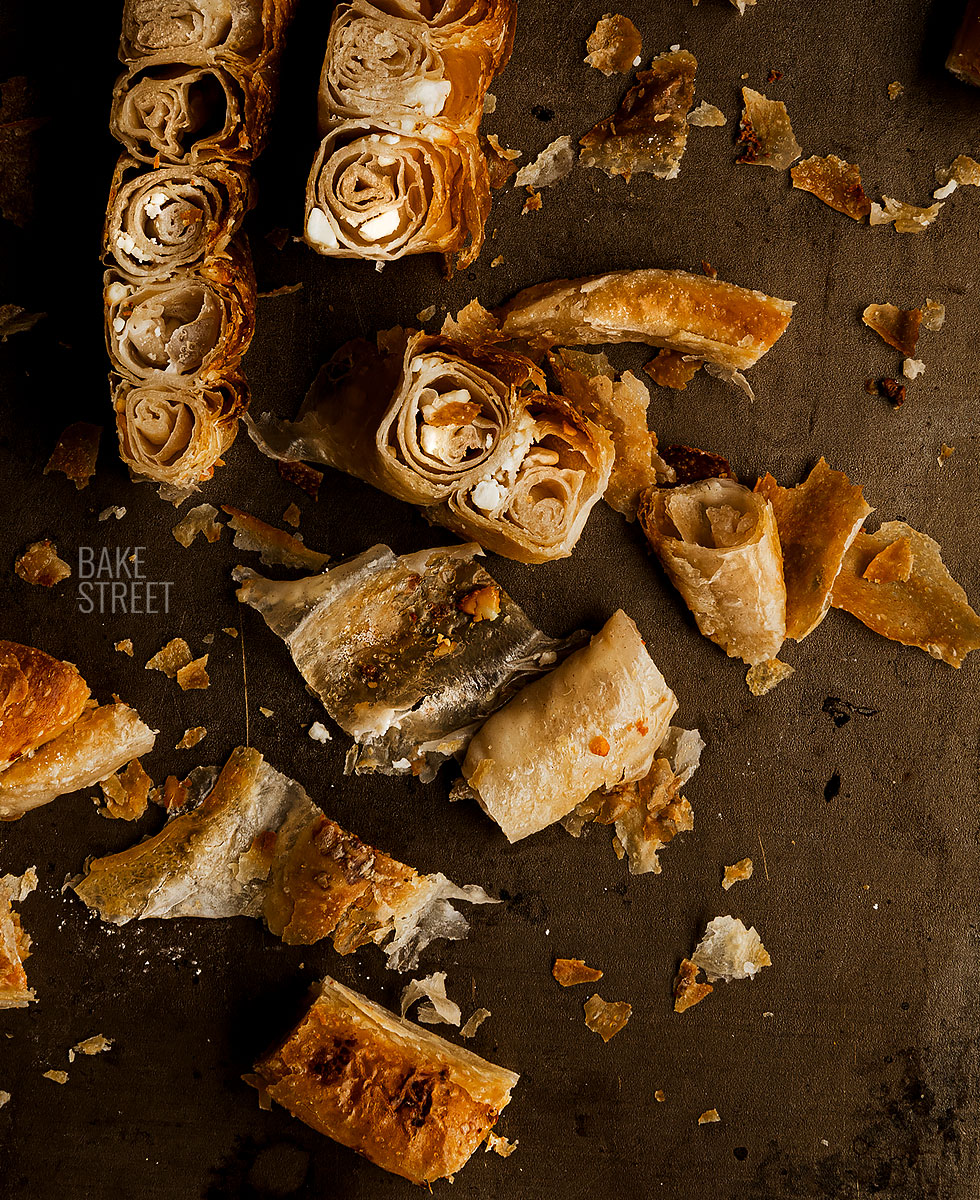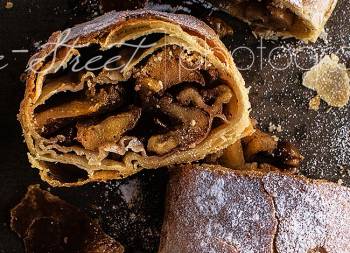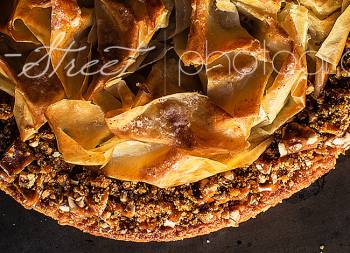
Banitsa, Bulgarian pie
This recipe for Banitsa, Bulgarian pie, I saw it to a person I admire a lot and some time ago I told her that I was going to make it. Better late than never! First of all, thank you Addie (Bread Stalker) for this fabulous discovery and recipe. We loved it at home and, without a doubt, I will continue to make it from now on. With this and other fillings 😉
To elaborate the banitsa recipe I have been guided by the recipe that Addie shared on her Instagram profile. I adapted the flours and the final amount of water to the flours I had at home. In fact I did the test with two different doughs using two different combinations of flours in which I had to adjust the amount of water, according to their absorption capacity. If the type of flour is suitable for a dough like this, it will give good results. It is important to use high-strength flours, which can be combined with a high-strength flour, but which also provides a good ratio of elasticity and extensibility.
It had been a while since I had worked with a dough of this type and I have to say that I didn’t know how much I missed it until I started working with it. For me it is immensely gratifying to work, stretch and shape a dough of these characteristics. For me it is a therapy of relationship and maximum evasion. Of course, I already tell you that it is not a dough that we can make under pressure, rush or situations that make us run.
The moment we decide to do it we have to make sure that we can dedicate the time it requires. Because stretching a dough like this will take time, we must work with care and delicacy.
I have prepared this recipe twice before sharing it with you, so that I have been able to correct mistakes I had in the first one, besides giving you 2 combinations of flours with their final hydration, as well as two ways to carry out the final proofing. That way you will be able to adjust it better to your schedule.
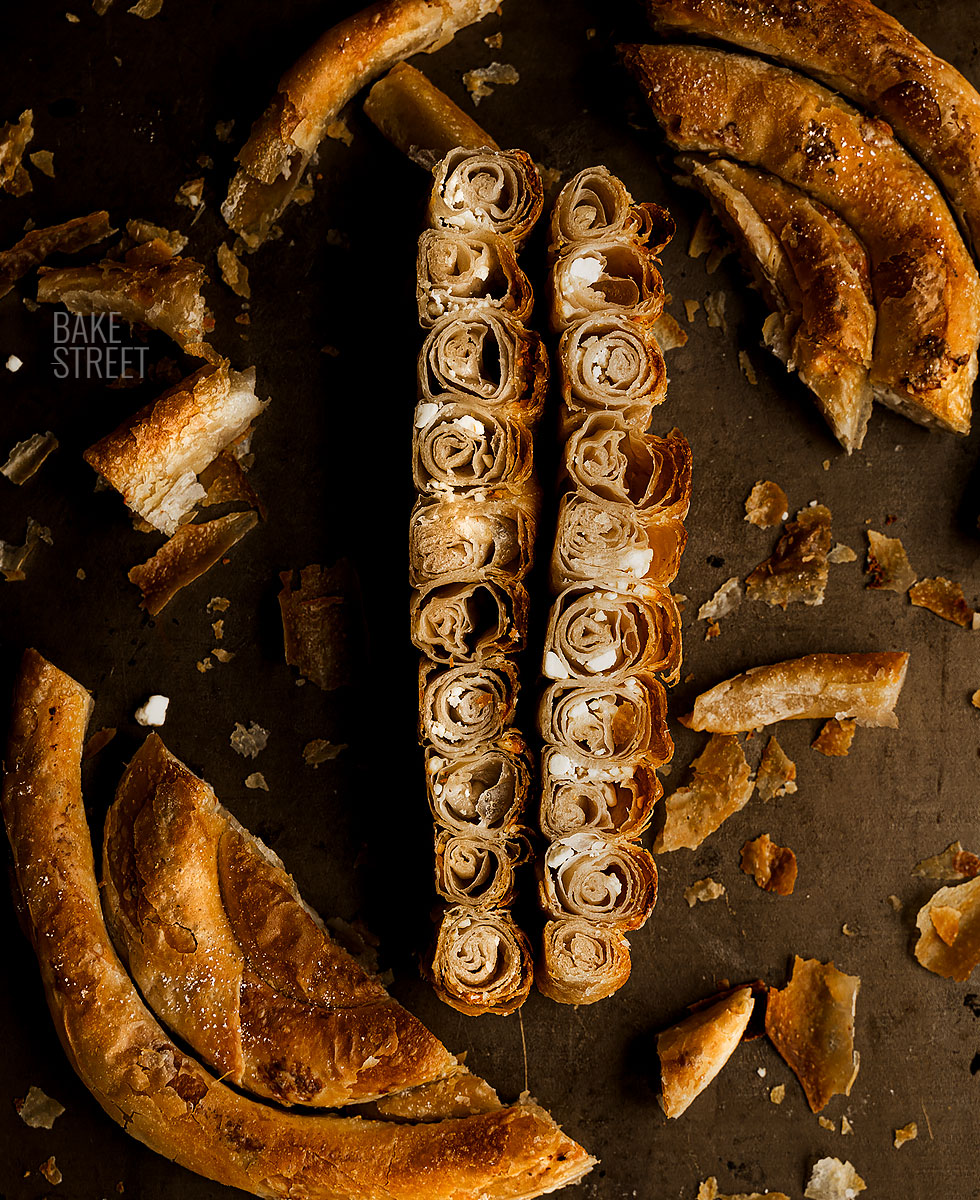
Leyends.
A Bulgarian legend says that when God created the world, He rewarded some countries with the most beautiful sea, others with the desert, others with pastures and mountains…. When it was Bulgaria’s turn, there was nothing left to give, so God collected the best of each country and offered them to Bulgaria.
Bulgarian cuisine is said to be the perfect reflection of this legend, as it represents Eastern European gastronomy and is one of the pillars of Balkan cuisine.
Banitsa origin.
Banitsa, also called banitza or banica, in Bulgarian баница, is a traditional Bulgarian dish made with filo dough, a mixture made from eggs, yogurt and sirene cheese(a variety of Bulgarian cheese). In addition to the classic cheese filling, this pastry can be prepared with a wide assortment of fillings either sweet (fruit) or savory (vegetables, meat…). In fact, in my case, I combine a savory ingredient, cheese, with a sweet one, apple spiced with cinnamon.
The variants with vegetables are called zelnik(зелник), from the word зелен ( Zelen ) meaning “green“. The leek variant is called praznik (празник) and the onion variant is called luchnik(лучник).
This preparation has a traditional and cultural origin, it was customary to prepare it for festivities such as Christmas, New Year and Easter during the X-XI centuries.
The word баница derives from the South Slavic гъбнѫти meaning “to bend“.
Archbishop Theophylact of Bulgaria, who lived in the 11th century, described in his letters the traditional diet of the Bulgarians of Pirin Macedonia, which included banitsa. Moreover, in the literature of this period, the banitsa not only symbolized the rural idyll in the original sense, but was also a structural element of the World Order and the national Cosmogony, where the sky was a “vryshnik“, and the earth was a uniform cake like a rolled dough.
When God decided to cover the earth with the sky, it turned out to be bigger and did not pass under the cover. It is for that reason that God decided to flatten it and that is how the earth was covered with folds, like a banitsa. This action symbolized the formation of mountains and plains among the ancient Bulgarians.
Centuries later, the leader of the national liberation movement, Georgy Rakovsky, described in detail “the most delicious Bulgarian banitsa, or mlyn, that many educated European travelers tasted in Bulgaria.”
In fact, many foreigners who visited Bulgaria between the 17th and 19th centuries left written memories of banitsa in diplomatic reports, travel notes, letters and memoirs.
“Bulgarians have a very tasty food, which is made of flour, cheese and honey. It is called “mlyn“, and I highly recommend it to anyone visiting Bulgarian cities” James Baker, British citizen, author of the book “European Turkey” in 1874.
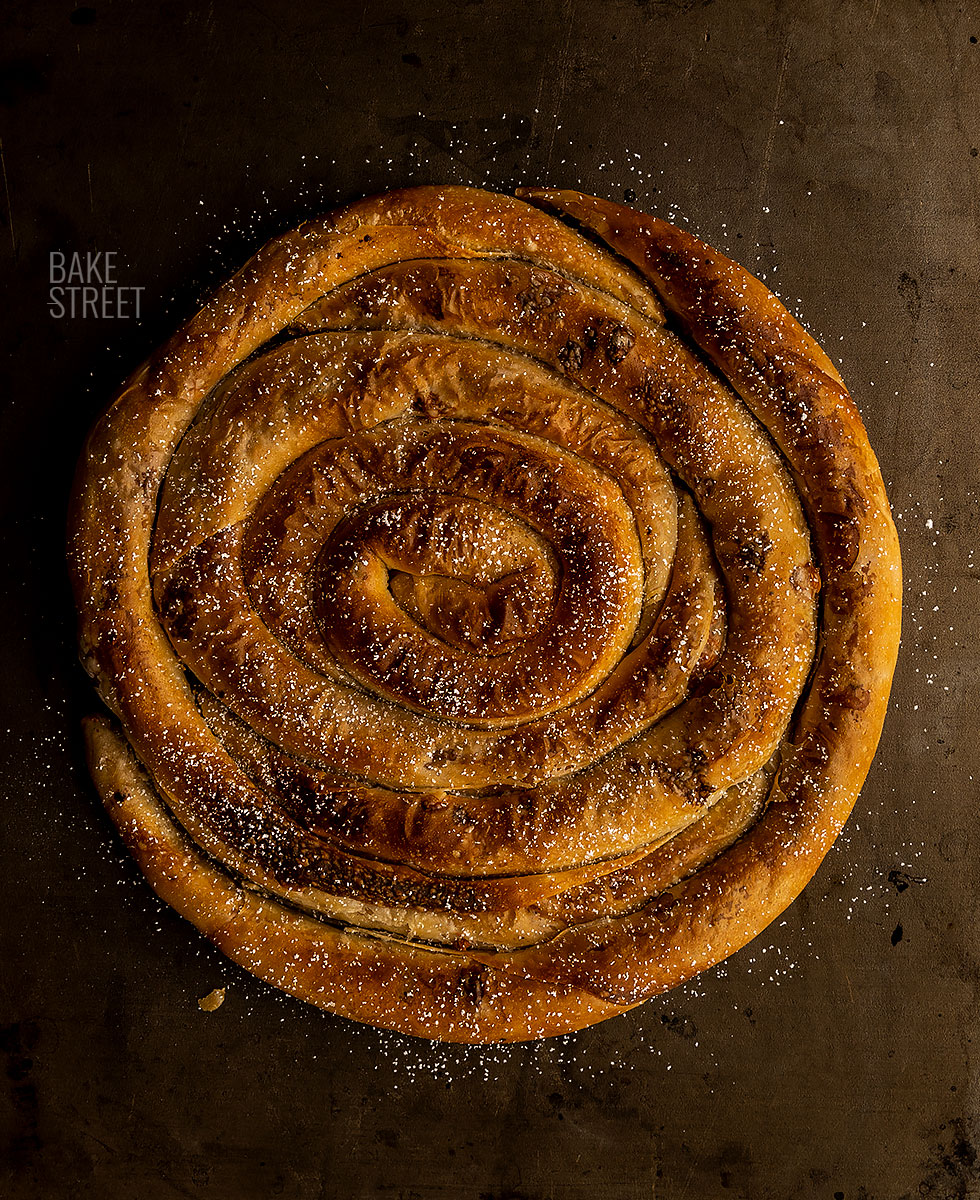
It could be a evolution from the famous Börek.
Symbology.
In Bulgaria, banitsa is a symbol of Bulgarian cuisine and traditions. Traditionally, Bulgarians prepare and serve banitsa on two holidays: Christmas and New Year’s Eve.
On these days, people add kusmeti(literally luck, meaning fortune or lucky charm) into the banitsa. These are usually small pieces of dogwood branch with different amount of buds, symbolizing health and longevity. The branches are hidden inside the banitsa before baking.
When ready, the banitsa is cut into as many portions as there are family members and each piece contains one dogwood branch. In addition, two additional pieces of banitsa are cut, one for the house and one for the Virgin Mary, protector of the family.
One wish is granted for each branch and the different number of shoots from it helps to fulfill the corresponding wish. Wishes include happiness, health, success, travel, etc. Before taking a portion, the banitsa is rotated on the table and, once it stops, each person takes the portion in front of him or her. In this way, each member of the family finds his or her fortune inside.
Alternatively or in addition to the kusmeti, some add a coin or small pieces of paper with fortunes written on them (in the same way as fortune cookies). In this case, they are wrapped in aluminum foil to preserve them during baking.
Making banitsa.
This pie is made with filo dough. It is true that the quickest way to make it is to use store-bough phyllo dough, but it is also true that the final result has nothing to do with a home-made dough. On the other hand, a filo dough is not a leveaned dough? So maybe you ask me, why do you add sourdough if this dough is an unleavened dough?
Very good question, maybe I should not say in this case that it is a filo dough, but a leavened dough with a thickness similar to onion paper (in my case, not so much, I must practice more). The point is that reading Addie, I really wanted to make it with sourdough. She said that the end result was much lighter and airy. I can guarantee that the end result is extraordinary! Both in how light it is, mind you, taking into account the amount of butter it contains? As in the final flavor. At home they loved it.
On the other hand, banitsa is traditionally filled with sirene cheese. This type of cheese is a variety in brine that can contain up to 7% salt, just like feta cheese.
Another type of banitsa called tutmanik (тутманик) or poparnik (попарник) is made with leavened dough, but it is not a thin dough, but bread-like. The usual filling is cheese.
In my case, I have also added slightly sweetened and spiced apple. You can also add it or omit it, as you prefer.
Recipe Banitsa, Bulgarian pie
DOUGH:
- 280 g high strong flour or Manitoba, W=380-400
- 220 g bread flour, W=200
- 335-340 g water (I used 334 g)
- 130 g sourdough hydrated to 50%
- 3 g vinegar
- 10 g salt
FILLING:
- 200 g sirene cheese or feta cheese, instead
- 2-3 Fuji apples + 2Tbsp sugar + 1 tsp cinnamon powder
FOR BRUSHING:
- 250 g unsalted butter, melted
MATERIAL WE WILL NEED:
- kneader
- saucepan
- scraper
- digital kitchen scale
- pastry brush
- sharp knife or pizza cutter
- bowls
- mold 24 cm diameter + 3 molds 12 cm diameter or one round mold 30 cm diameter
Instructions
NIGHT BEFORE OR FIRST THING IN THE MORNING
Refresh sourdough.
- Refresh sourdough in a 1:1:2 ratio, i.e. one part sourdough : one part water : 2 parts flour. We will need 35 g of sourdough + 35 g of water + 70 g of high-strength flour/Manitoba.
- Mix all the ingredients until we obtain a homogeneous dough, it is not necessary to work it a lot.
- Place it in a container that allows us to control its growth and to know when it has doubled its volume. We mark on the outside the maximum height, cover with film and let it rise.
- In this step I give you two different schedules that I have carried out so that you can adjust it to your needs.
- Refresh at 00:00 in the evening and it will be ready around 6:30 in the morning at about 69,8ºF/21ºC.
- Reefresh at 8:00 in the morning and it will be ready around 14:00 in the afternoon at 69,8ºF/21ºC.
- A sourdough hydrated to 50% at a temperature around 69,8ºF/21ºC, will take about 6 hours or 6 hours and a half to reach twice its volume. With this data you can calculate the schedule that best suits you.

Prepare the dough.
- In the bowl of the kneader, add the two types of flour together with the chopped sourdough, the vinegar and part of the water. Since each flour has a different absorption capacity, I advise you not to add all the amount that I detail. Reserve about 40-50 g and observe the dough when it has been kneading for a while. Touch it and check that it can admit some more water. We will always have time to add more water, but we can not remove an excess of it. Doughs are corrected with water, never with flour.
- When we have been kneading for about 4-5 minutes, add the salt.
- The dough will take a while to knead and you will have to stop the mixer several times to help it. Until it begins to develop gluten, it will remain in the flattened base.
- We must achieve a very well developed dough.
- Once at this point, remove from the mixer and round (make a ball).
Make first rest.
- Put the dough in a bowl, cover with film or a shower cap and let it rest for 1 hour.
Divide the dough and let it rest again.
- Divide the dough into 8 equal pieces.
- Roll very gently, cover with plastic wrap and let rest for 45 minutes.
Shape banitsa.
- Melt the butter, it is not necessary to temper it, but it is not necessary to use boiling butter and proceed to stretch the dough pieces.
- Keep the other pieces covered while you stretch one of them.
- Dip the piece in the butter and begin to stretch it between our fingertips. Start to thin the central part of the piece by sliding our fingers. It is important to keep the dough greased to help it stretch very well.
- Once the central part is more or less thin, place it on a work table and begin to stretch it. You can slide both hands over it or can hold one of the ends while holding the other with the other hand and continue stretching. Do this very carefully to avoid tearing the dough, it is delicate.
- It is completely normal that we make some small holes. That's ok, it will not be appreciated in the final result.
- Once you have the dough stretched, you should be able to read through it. Cut the edges. These, as usual, will be somewhat thicker.
- Sprinkle the surface with some melted butter and with a little crumbled cheese and grated apple, previously very well squeezed to avoid moisture.
- Roll the dough over itself and place it inside the mold.
- Proceed to shape the rest of the pieces in the same way.
- In my case I used a mold of 24 cm in diameter and 3 molds of 12 cm in diameter. But this amount of dough allows us to use a mold of 30 cm in diameter or adjust it in different molds that you have at home.
Make final proof.
- Brush the surface with melted butter, cover with film and make the final fermentation. In this step you can do it in two different ways, cold-retarding and without retarding.
- If you do the process immediately, leave a final fermentation of 4-6 hours at 78,8-80,6ºF/26-27ºC.
- If you make a cold-retarding, leave 2 hours at room temperature (in my case 69,8ºF/21ºC), then place in the refrigerator for 10 hours at 4ºC, the next morning take out of the cold and leave 3 hours at 80,6-82,4ºF/27-28ºC.
- The final result can be seen in its volume, it will have increased slightly and, to the touch, you will notice air pockets.

Bake.
- Preheat the oven to 374ºF/190ºC with heat up and down.
- Line the bottom of the molds with aluminum foil, because it will overflow with butter, and place on a rack in the lowest part of the oven for 60 minutes.
- Remove, let stand in the mold for 10 minutes and unmold.
- Before serving, if desired, we can sprinkle a little powdered sugar.
Notes
- To make this dough it is important to use a strong or Manitoba flour that has good elasticity and extensibility. In my case, I made it using two different combinations of flour; 280 g high-strength flour + 220 g bread flour, this dough needed 334 g of water and another using 220 g high strong flour/Manitoba + 280 g Viennoiserie flour (W=300, approximately), this dough needed 314 g of water. For this reason, I advise you to add the water little by little to be able to control the total quantity needed and not to exceed it.
- Vinegar, like lemon juice, will help make the dough more elastic.
- Filo dough is not a leavened dough, but I really liked Addie's idea of adding sourdough to the dough and allowing it to undergo a leavening process. It is true that the end result is lighter and airier, it is worth trying to make it.
- It is important to make sure that the dough is well greased, this will help you to roll it out more easily and efficiently.
- I advise you to stretch the dough between your hands rather than with a rolling pin. In the first case, we will be able to thin the dough more easily, especially the central part, and work it in a delicate way.
- It does not matter the final shape of the stretched pieces, it can be rectangular or oval. The important thing is that after stretching it, it should be very thin. When the pieces are rolled they will all be very similar to each other.
- Do not forget to trim the edges of the stretched pieces. This part is thicker and, after baking the dough, it will not fit well together with the other thinner dough.
- The original banitsa filling is made with cheese, but I really liked the spiced apple option (Addie's idea). So I decided to combine the two.
- The filling can be adapted to your taste.
- If you cannot find sirene cheese, you can use feta cheese. Both cheeses are quite similar, but not the same.
- Ideally it should be consumed on the same day, but it can be kept in an airtight container for 1-2 days.

I know it is a laborious dough, for several reasons, but I also recognize that if you make this Banitsa, Bulgarian pie, you will not regret it... Never. It is one of those recipes that you know will give you a lot of work, but the final reward is going to be really incredible.
Not only when you see the final result and all our work behind it, but also because of how incredibly delicious it is. When I made it, both times, it reminded me a lot of the process of making ensaimadaand strudel. They are doughs that, if you like to work with this type of dough, make you enjoy a lot and bring you an incredible well-being.
If you dare to prepare it, let me know how you did with it! I wish you a wonderful weekend.
Lots of love,
Eva
Sources: Hmong, 196 Flavors


